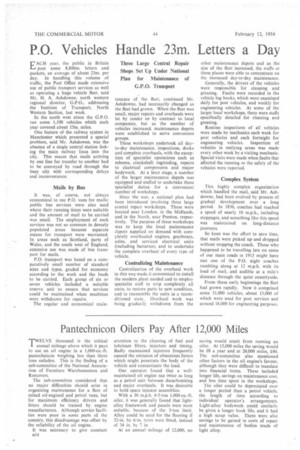P.O. Vehicles Handle 23m. Letters a Day Three Large Central
Page 48

If you've noticed an error in this article please click here to report it so we can fix it.
Repair Shops Set Up Under National Plan for Maintenance of C.P.O. Transport EACH year, the public in Britain post some 8,800m. letters and packets, an average of about 23m. per day. In handling this volume of traffic, the Post Office made extensive use of public transport services as well as operating a huge vehicle fleet, said Mr. H. A. Ashdowne, north western regional director, G.P.O., addressing the institute of Transport, North Western Section, last week.
In the north west alone the G.P.O. ran some 1,100 vehicles which each year covered about 15m. miles.
One feature of the railway system in Manchester which presented a special problem, said Mr. Ashdowne, was the absence of a single central station linking the main railway lines into the city. This meant that mails arriving by one line for transfer to another had to be conveyed by road through the busy city with corresponding delays and inconvenience.
Mails by Bus It was, of course, not always economical to use P.O. vans for mails; public bus services were also used where their running times were suitable and the amount of mail to be carried was small. The employment of such services was not so common in densely populated areas because separate means for transport were warranted. In areas such as Scotland, parts of Wales. and the south west of England, extensive use was made of bus transport for mails.
P.O. transport was based on a comparatively small number of standard sizes and types, graded for economy according to the work and the loads to be carried. Each group of six or seven vehicles included a suitable reserve unit to ensure that services could be maintained when machines were withdrawn for repairs.
The regular and economical main tenance of the fleet, continued Mr. Ashdowne, had necessarily changed as the fleet had grown. When the fleet was small, major repairs and overhauls were let by tender or by contract to local companies, but as the number of vehicles increased, maintenance depots were established to serve convenient groups.
These workshops undertook all dayto-day maintenance, inspections, docks and complete overhauls, with the exception of specialist operations such as rebores, crankshaft regrinding, repairs to electrical components and major bodywork. At a later stage, a number of the larger maintenance depots was equipped and staffed to undertake these specialist duties for a convenient number of workshops.
Since the war, a national plan had been introduced involving three large central repair workshops. These were located near London, in the Midlands, and in the North, near Preston, respectively. The purpose of these workshops was to keep the local maintenance tkpots supplied on demand with completely overhauled engines, gearboxes, axles, and serviced electrical units (including batteries), and to undertake the complete overhaul of every type of vehicle.
Centralizing Maintenance
Centralization of the overhaul work in this way made it economical to install the modern plant needed and to employ specialist staff to strip completely all units, to restore parts to new condition, and to reassemble the units in a reconditioned state., Overhaul work was being gradually withdrawn from the other maintenance depots and as the size of the fleet increased, the staffs at these places were able to concentrate on the increased day-to-day maintenance.
Generally, the drivers of the vehicles were responsible for cleaning and greasing. Faults were recorded in the vehicle log books, which were examined daily for post vehicles, and weekly for engineering vehicles. At some of the larger local workshops, there were staffs specifically detailed for cleaning and greasing.
Routine inspections of all vehicles were made by mechanics each week for post vehicles and each fortnight for engineering vehicles. Inspection of vehicles in outlying areas was made every other week by a visiting mechanic. Special visits were made when faults that affected the running or the safety of the vehicles were reported.
Complex System
This highly complex organization which handled the mail, said Mr. Ashdowne, had been evolved by process of gradual development over a long period. In 1836, coaches had reached a speed of nearly 10 m.p.h., including stoppages, and something like this speed was maintained on long-distance journeys.
So keen was the effort to save time. that mails were picked upand dropped without stopping the coach. Those who happened to be travelling late on some of our main roads in 1913 might have met one of the P.O. night coaches rumbling along at 12 m.p.h. with its load of mail, and audible at a mile's distance through the quiet countryside.
From those early beginnings the fleet had grown rapidly. Now it comprised some 31,000 vehicles, about 13,000 of which were used for post services and around 16,000 for engineering purposes.




































































































